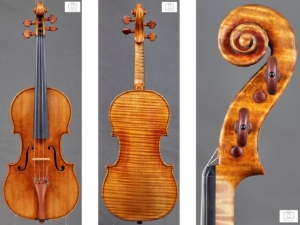
It belongs to that generation of larger instruments in which the famous Cremonese luthier abandons the Amati tradition for his own reference model. Recent studies conducted in England, in fact, have identified geometric correspondences with the “PG” shape, the same used for the construction of the famous Messiah 1716 violin. The history of Hegedüs has been documented since 1801, when Johan Betts noted its ownership by Captain Coggan. It is likely that it was already in London, perhaps brought by one of the Italian musicians who moved across the Channel in the 18th century. The instrument then passed to Mr Wasborough of Bristol and, later, to a family called the Purriers, one of whose members was a musician at the court of King George III. It remained in their possession until the mid-19th century, when it was sold to Dr Selle, of Richmond, Surrey. In 1907 it was purchased by Hill & Sons and, in 1932, sold to Robert Bower, then to Ferencz Hegedüs (1881-1944), famous Hungarian soloist and conductor: born in Fünfkirchen, son of two musicians, he studied at the Budapest Conservatory with Jenö Hubay. His interpretative style had the typical characteristics of the Hungarian violin school, but these traits were toned down in the interpretations of authors of the classical era. He made his London debut at the age of 16. He lived in Switzerland until 1930, then moved to England. In September 1933 the instrument was presented by the famous lutherie magazine The Strad. Now it will be possible to admire it in the “Treasure Chest” of the Violin Museum until next spring.

